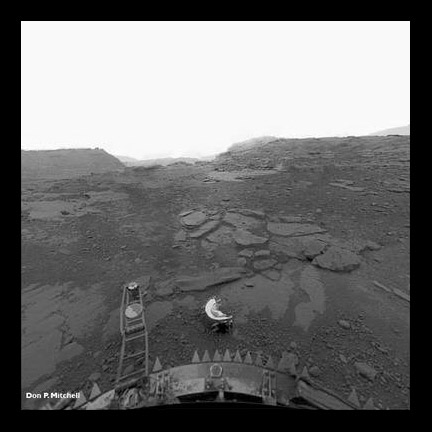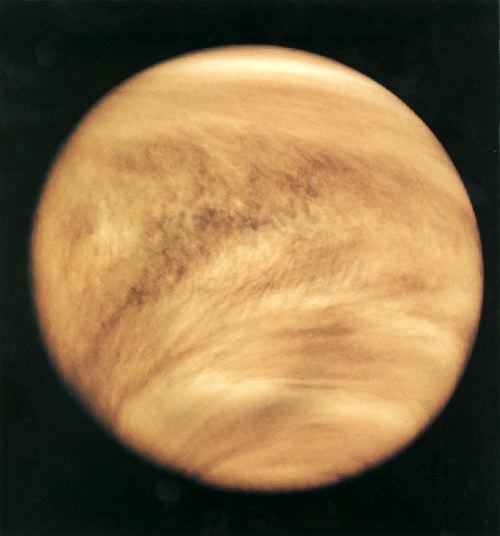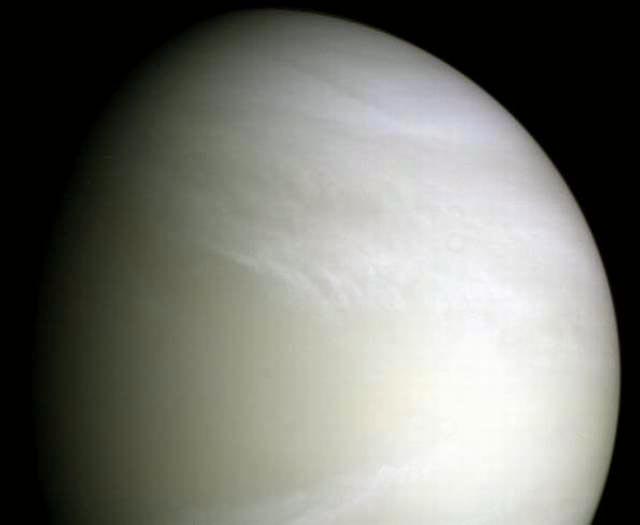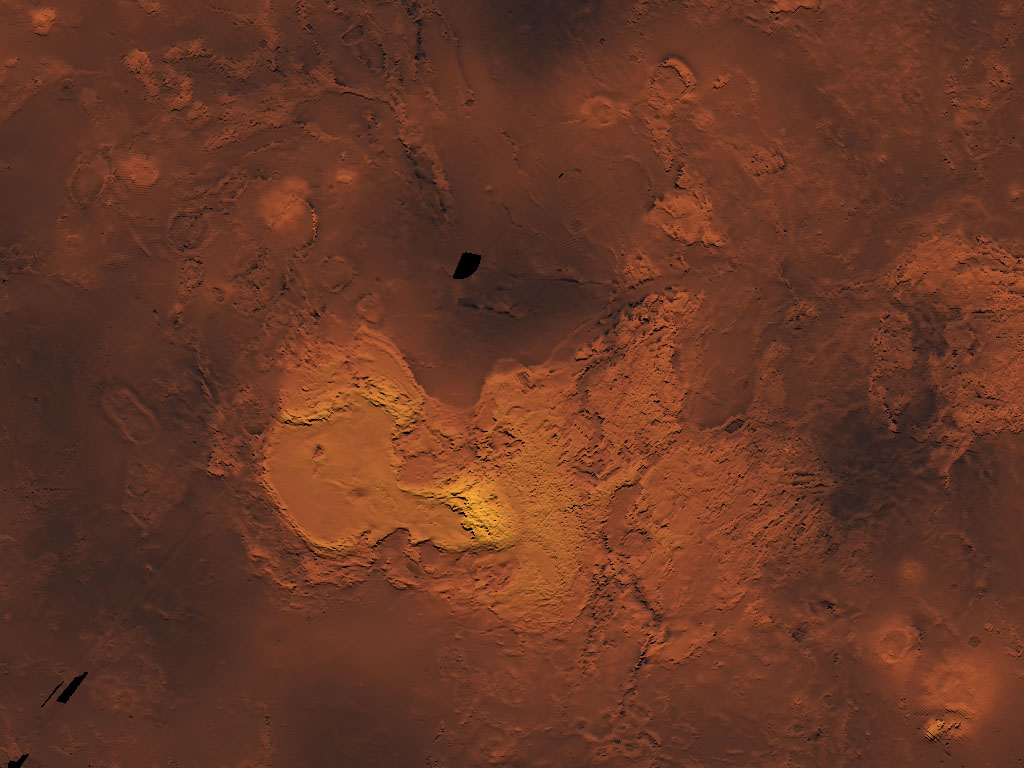It looks like you're using an Ad Blocker.
Please white-list or disable AboveTopSecret.com in your ad-blocking tool.
Thank you.
Some features of ATS will be disabled while you continue to use an ad-blocker.
share:
Originally posted by Ixtab
reply to post by Drunkenparrot
Didnt see any of those crazy serrated teeth from the photo on the probe. Whats that all about?
They are covered by the still attached heat shield in the photo...
Metal teeth ringing the landing pad were added to aerodynamically stabilize the lander and prevent spinning and oscillations which may have damaged Venera-11 and 12.
Drilling into the Surface of Venus
Originally posted by ShaunSwindon
Test.
Getting your post count up to post something mate? I would at least try to contribute something.
Originally posted by JibbyJedi
Cells adapt to their environments. There is life under water at extreme cold temperatures and pressures to which no life on Earth's surface could survive, but they thrive down there.
No reason to assume there isn't life on Jupiter even, people base their knowledge of "life" on what they know of Earth's surface lifeforms.
Look how strange these lifeforms look. If we saw a "still photo" of these for the 1st time ever, would we think they are living creatures?
The release of such information shouldn't take 30 YEARS to become public. But that's how we roll here, what's discovered by the elite today is taught to us 40 years later. It's called leverage.
edit on 20-1-2012 by JibbyJedi because: (no reason given)
People base there knowledge of life on TV documentarys.Its a shame.
Originally posted by JibbyJedi
Cells adapt to their environments. There is life under water at extreme cold temperatures and pressures to which no life on Earth's surface could survive, but they thrive down there.
No reason to assume there isn't life on Jupiter even, people base their knowledge of "life" on what they know of Earth's surface lifeforms.
Look how strange these lifeforms look. If we saw a "still photo" of these for the 1st time ever, would we think they are living creatures?
The release of such information shouldn't take 30 YEARS to become public. But that's how we roll here, what's discovered by the elite today is taught to us 40 years later. It's called leverage.
edit on 20-1-2012 by JibbyJedi because: (no reason given)
People base there knowledge of life on TV documentarys.Its a shame.
Originally posted by AmatuerSkyWatcher
What qualifications have you got to counter his statements?
Common sense, European school education and a rather high IQ?
Ok..seriously...you do not see this is a broken tube-like thing, there is even bolts on the side. Something which was attached to the probe.
Originally posted by ShaunSwindon
Test.
Nope. Nothing.
Try typing loudly and slower.
reply to post by JimOberg
Highly unlikely. Here is a photo from Venera 13. en.wikipedia.org...:Venera_13_-_venera13-left.jpg
I don't see any men in there. The pressure was so bad that the probe only lasted 127 minuutes. I highly doubt there could be life there.
Crap. The link isn't printing all the way out. Just go to Wiki and look up Venera 13 and you can see some great pictures.
Highly unlikely. Here is a photo from Venera 13. en.wikipedia.org...:Venera_13_-_venera13-left.jpg
I don't see any men in there. The pressure was so bad that the probe only lasted 127 minuutes. I highly doubt there could be life there.
Crap. The link isn't printing all the way out. Just go to Wiki and look up Venera 13 and you can see some great pictures.
edit on 20-1-2012 by
Alienmojo because: Link wouldn't work.
Originally posted by Cassius666
Average temperature is well above 1500 Fahrenheit. Whatever would live there cant be carbon based. Atmosphere is primarily Co2. Our hypothetical scorpion would have to resist high temperatures and breathe the way trees breathe.
Wait until you and everybody else realize that the temperature is actually pretty close to what it is here on earth.
If a Planet is close to the sun, the planet compensates and adapts to be able to sustain life....just like life itself adapts.
DUH !
so do planets that are farther from the sun.
How does that ^ not make perfect sense considering how life works here and elsewhere ?
Originally posted by ALOSTSOUL
reply to post by JimOberg
Heres a picture of Venus's surface taken by the same mission there referring to the the OP.
If I remember rightly they didn't take many pictures because the camera melted.
ALS
edit on 20-1-2012 by ALOSTSOUL because: (no reason given)
That is the most incredible picture I have ever seen of that mission! Where did you find it??? All the ones that I have seen never show a horizon.
Okay, don't yell at me too bad if I'm wrong, BUT... do you think it's at all possible that they didn't release any pics of the creatures they
found and the pics we are looking at here are just the landing area? And that thing we are all studying is actually a mechanical - whatever. What do
you think?
The first mistake is believing that life can only exist in similar situations as us.
Which i don't believe for a second
I'm sure there are some living things on venus, mars too, hell, even saturn. 'Who knows!',
Such a mystery. I wonder if we'll get space travel soon (i mean real space travel, explore the outer reachers of the galaxy in a decent timeline.
Faster than light travel anyone?
Which i don't believe for a second
I'm sure there are some living things on venus, mars too, hell, even saturn. 'Who knows!',
Such a mystery. I wonder if we'll get space travel soon (i mean real space travel, explore the outer reachers of the galaxy in a decent timeline.
Faster than light travel anyone?
Originally posted by Drunkenparrot
I always thought it was sulphur yellow?
NSSDC Photo Gallery Venus
Depends on your source
If colors are estimated correctly, there is a final issue of tone mapping. How bright does the image appear to the eye in a given context. The image above is the best color image of Venus I've found, showing the planet as it would likely appear to a human observer in space. It was made by Turkish astronomer A. Tayfun Oner, using the two color channels from the Galileo camera, and a third interpolated channel.
mentallandscape.com...
Venus - Galileo
Color enhanced image of Venus from 2.7 million km
nssdc.gsfc.nasa.gov...
www.space.com...
www.spacetoday.org...
And NASA LOVES to use that Brite LAVA ORANGE to colorize images of Venus... Never figured out why
WHY is it Orange? Its a RADAR image not a color picture...
Will the REALVenus please stand up
edit on 20-1-2012 by zorgon because: (no reason given)
Originally posted by LucidDreamer85
Originally posted by Cassius666
Average temperature is well above 1500 Fahrenheit. Whatever would live there cant be carbon based. Atmosphere is primarily Co2. Our hypothetical scorpion would have to resist high temperatures and breathe the way trees breathe.
Wait until you and everybody else realize that the temperature is actually pretty close to what it is here on earth.
If a Planet is close to the sun, the planet compensates and adapts to be able to sustain life....just like life itself adapts.
DUH !
so do planets that are farther from the sun.
How does that ^ not make perfect sense considering how life works here and elsewhere ?
I heard the surface is covered in lush tropical vegetation and is populated by dinosaurs...
The CO2-rich atmosphere, along with thick clouds of sulfur dioxide, generates the strongest greenhouse effect in the Solar System, creating surface temperatures of over 460 °C (860 °F). This makes the Venusian surface hotter than Mercury's which has a minimum surface temperature of −220 °C and maximum surface temperature of 420 °C, even though Venus is nearly twice Mercury's distance from the Sun and thus receives only 25% of Mercury's solar irradiance...
Thermal inertia and the transfer of heat by winds in the lower atmosphere mean that the temperature of the Venusian surface does not vary significantly between the night and day sides, despite the planet's extremely slow rotation
Atmosphere of Venus
They found NEWTS X girl friend on venus having a OPEN relationship ..
edit on 20-1-2012 by Josh342 because: (no reason given)
reply to post by zorgon
The photo's you are posting are processing the image through artificial color filters.
In the visible light spectrum Venus is distinctly pale yellow ( I've seen it quite a few times through a decent telescope )
Ask an Astronomer
The photo's you are posting are processing the image through artificial color filters.
In the visible light spectrum Venus is distinctly pale yellow ( I've seen it quite a few times through a decent telescope )
What color is Venus? I have looked at a lot of pictures of Venus but they are all different colors. Do you know what color Venus really is?
Good question. Most pictures of Venus have some sort of false color to bring out details. Astronomers do this a lot when they want to make certain features or information more obvious. If we looked at Venus with our eyes above the atmosphere, we would see a really bright white-yellowish ball with essentially no features. Some pictures of the atmosphere show dark sideways V-shaped bands. These pictures were taking in ultraviolet light to show some cloud patterns, so we wouldn't see it like that in reality.
If we traveled down through the atmosphere to the surface, we would probably see brownish-red colored rocks. The rocks are probably similar to volcanic rocks here on Earth, but the thick atmopshere blocks a lot of light making the surface kind of dim with a reddish tinge. The bright red/orange pictures of the surface that you see associated with the NASA Magellan project are probably more red than what you would see if you were actually there. For example, if you look at this color picture of the surface, taken by a Russian spacecraft you can see it looks reddish. If you brought the rocks back to Earth light they would probably have a slightly different color, but they're reddish on Venus.
Also, some pictures of the surface are false rainbow-colored. These pictures show altitude information. Blue represents low areas and red and white are high altitudes.
Ask an Astronomer
edit on 20-1-2012 by Drunkenparrot because: syntax
It's difficult to conceive of any moving animal life on a planet with a temperature of over 850 degrees F and an atmospheric pressure similar to
what's encountered when diving a kilometer below the ocean. That makes it like a giant pressure cooker, except at much higher temperature and
pressure.
Originally posted by Drunkenparrot
The photo's you are posting are processing the image through artificial color filters.
yes my point...
PROCESSED
nssdc.gsfc.nasa.gov...
Just like the NASA RED they use to paint the Blue Skies of Mars
edit on 20-1-2012 by zorgon because: (no reason given)
On Venus, With a surface temperture of 464 degrees Celsius (867 degrees Fahrenheit), Not even bacteria mocrobes can survive. Sorry, but that's just a
scientific fact. With that being said, beneath the surface? That's an entire different discussion. Now, Try the other direction from the Sun and past
Earth. That is where life exists. ~SheopleNation
new topics
-
Orbs Appear And Form Triangle On Live Cam.
Aliens and UFOs: 47 minutes ago -
Biden Has New Bizarre Injuries to His Face
Politicians & People: 2 hours ago -
Something is not adding up in regards to the H-1B commotion
General Conspiracies: 2 hours ago -
Elon Musk Calls for Tommy Robinson to be Freed - and Takes a Dig at Starmer
Politicians & People: 3 hours ago -
Biden to award Presidential Citizens Medal to Liz Cheney and Bennie Thompson
US Political Madness: 3 hours ago -
Just learned a really helpful trick for internet searches
Computer Help: 9 hours ago -
Not off to a good start
General Chit Chat: 11 hours ago
top topics
-
Biden Has New Bizarre Injuries to His Face
Politicians & People: 2 hours ago, 8 flags -
Just learned a really helpful trick for internet searches
Computer Help: 9 hours ago, 7 flags -
Not off to a good start
General Chit Chat: 11 hours ago, 6 flags -
Biden to award Presidential Citizens Medal to Liz Cheney and Bennie Thompson
US Political Madness: 3 hours ago, 6 flags -
Elon Musk Calls for Tommy Robinson to be Freed - and Takes a Dig at Starmer
Politicians & People: 3 hours ago, 5 flags -
Something is not adding up in regards to the H-1B commotion
General Conspiracies: 2 hours ago, 4 flags -
Orbs Appear And Form Triangle On Live Cam.
Aliens and UFOs: 47 minutes ago, 0 flags
active topics
-
Biden to award Presidential Citizens Medal to Liz Cheney and Bennie Thompson
US Political Madness • 12 • : DAVID64 -
Biden Has New Bizarre Injuries to His Face
Politicians & People • 7 • : Dalamax -
US disburses $3.4 billion in budget aid for Ukraine, Yellen says
US Political Madness • 26 • : WeMustCare -
Orbs Appear And Form Triangle On Live Cam.
Aliens and UFOs • 1 • : Flyingclaydisk -
Tesla Cybertruck Explodes in Front of Trump Hotel in Las Vegas
Mainstream News • 94 • : WeMustCare -
Ukraine halts transit of Russian gas to Europe after a prewar deal expired
Political Conspiracies • 108 • : VictorVonDoom -
Something is not adding up in regards to the H-1B commotion
General Conspiracies • 26 • : charlest2 -
-@TH3WH17ERABB17- -Q- ---TIME TO SHOW THE WORLD--- -Part- --44--
Dissecting Disinformation • 3890 • : Thoughtful3 -
Trump's idea to make Canada the 51st US state: 'Potential is massive'
Mainstream News • 150 • : Oldcarpy2 -
Elon Musk Calls for Tommy Robinson to be Freed - and Takes a Dig at Starmer
Politicians & People • 8 • : BedevereTheWise








